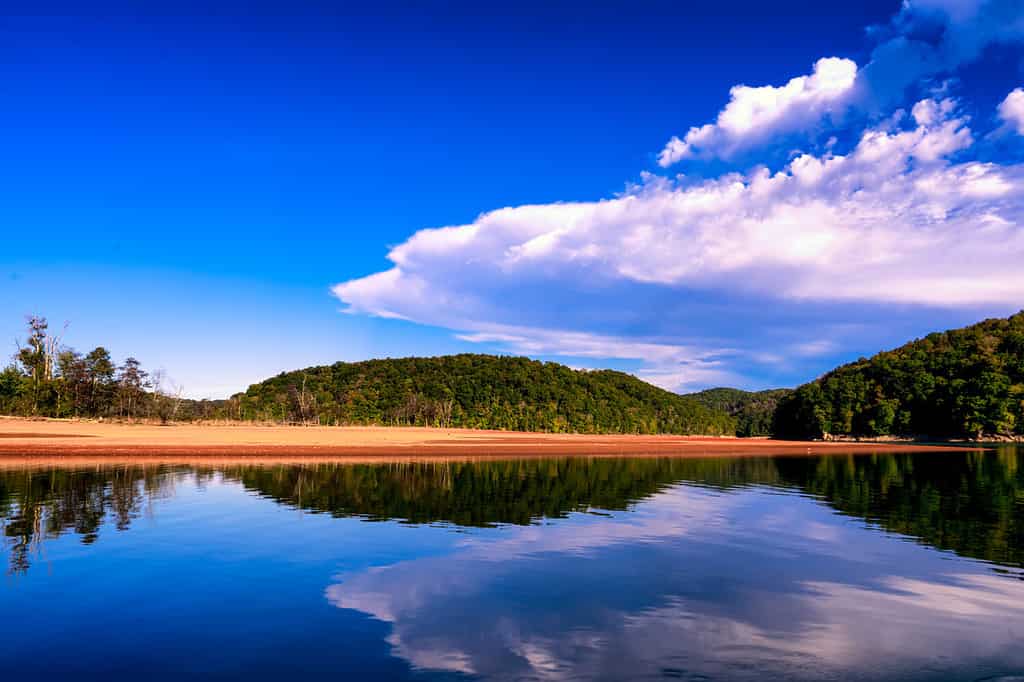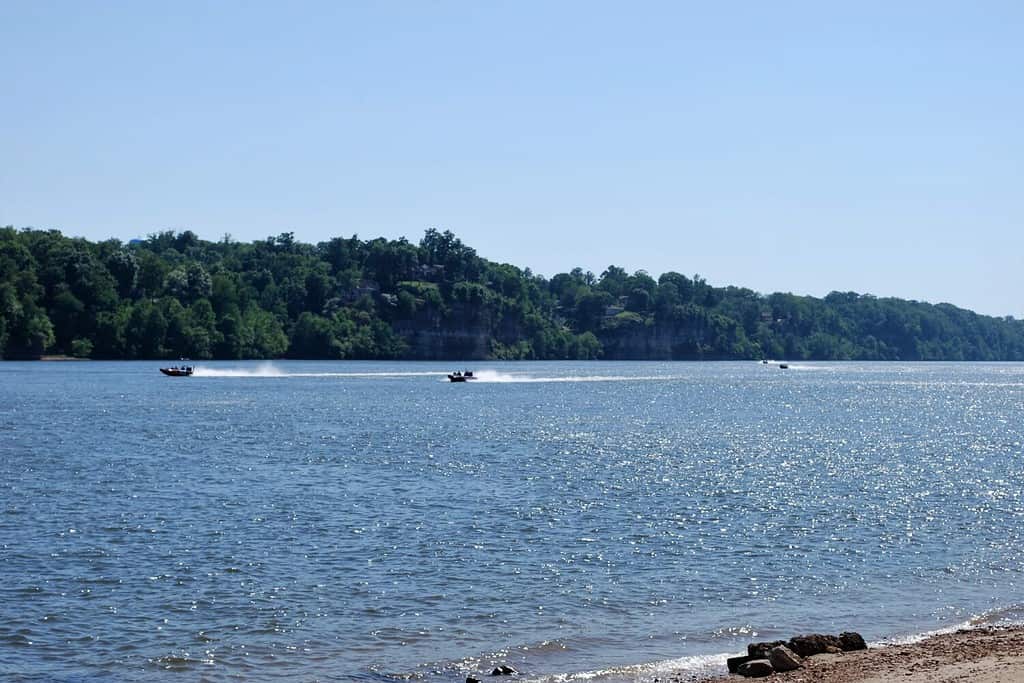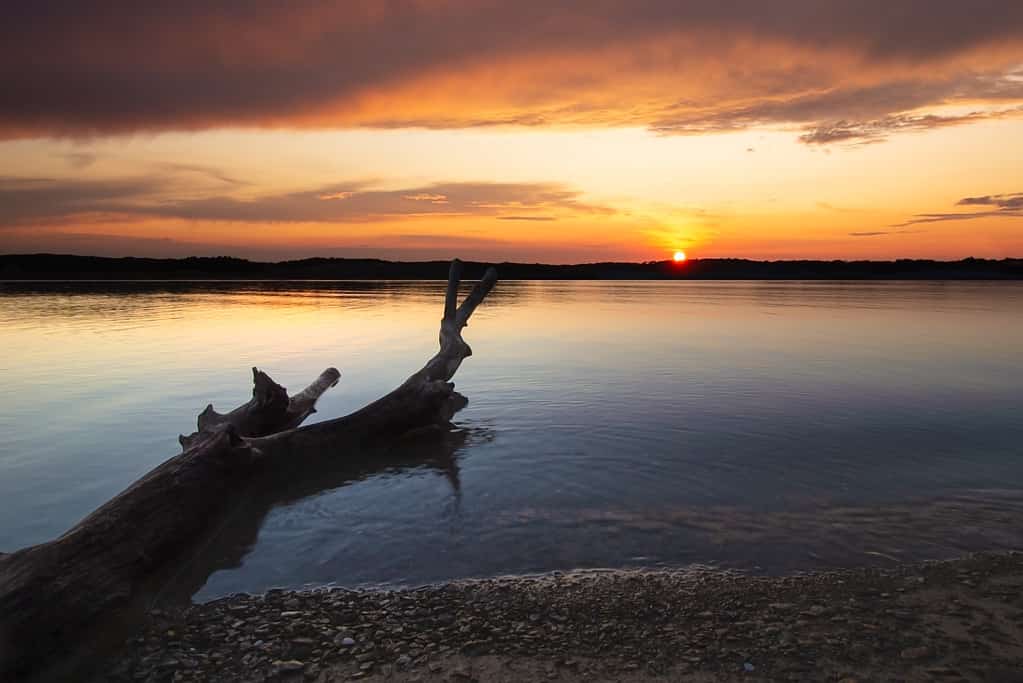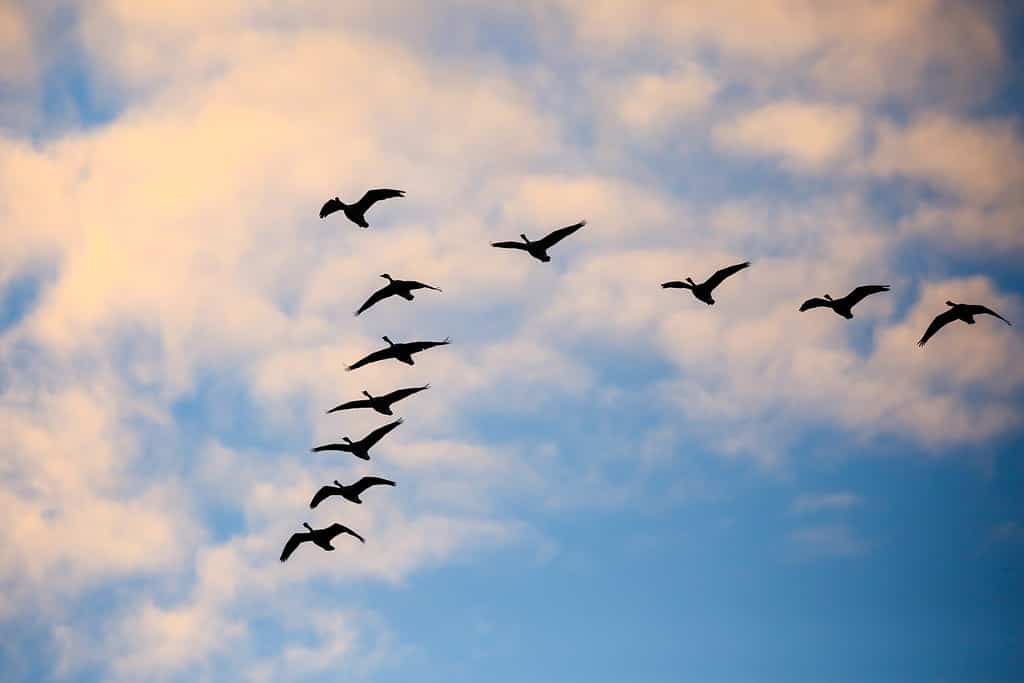If you’re looking for untainted beauty and optimum recreation, Tennessee‘s lakes offer unparalleled opportunity!
Natural Beauty
Growing up on Norris Lake (a Tennessee Valley Authority lake), I’ve explored its deep coves, pristine shoreline, caves, and beaches. It’s just as common to spot a bass jumping in a shallow inlet at sunset as witnessing a doe and her fawns swimming across the water to an island shore. A contrast to East Tennessee’s Norris Lake is Reelfoot Lake. A small wonder located in northwest Tennessee, wildfowl — ospreys, eagles, ducks, and herons — make their home amidst the abundant bald cypress trees native to the area. In Middle Tennessee, Center Hill Lake further showcases the diversity of this state’s lake aesthetics. Nearby, explorers will find a variety of scenic waterfalls such as the gorgeous and popular swimming hole of Cummins Falls and the towering cascades of Burgess Falls.

Norris Lake’s pristine shorelines are just one of the reasons it’s a beloved Tennessee lake.
©Stephen P Robinson/Shutterstock.com
In northern Middle Tennessee, Old Hickory Lake affirms the vast diversity and allure of Tennessee’s lakes. Old Hickory boasts the largest wading bird breeding colonies in the Central Basin area of Tennessee. It also showcases a huge variety of fish, including various bass and catfish species.

Magnificent Burgess Falls near Center Hill Lake is a regional favorite.
©3DNSEW/Shutterstock.com
Size and Depth
The variety of sizes and depths in Tennessee’s lakes certainly add to its aquatic notoriety. A wide array of choices exists, providing picks for every taste. Monstrous Pickwick Lake contains 43,098 acres. For a midsize lake, Nickajack Lake, near Chattanooga, covers 10,370 acres. For more seclusion, choose the shallow waters of Melton Hill Lake at 5,690 acres. Located in picturesque Anderson County, Melton Hill caters to a quiet morning of solitary casting.
As fishermen and boating enthusiasts know, depth matters. While shallow waters are conducive to procuring the ubiquitous bass, for instance, deeper depths are required to navigate larger watercraft. To enjoy shallow waters in Tennessee, head to the bass angler’s favorite: Chickamauga, near Dayton, Tennessee. Chickamauga’s claim to fame as a shallow gem maintains its top choice as a regular tournament venue. Conversely, if you yearn to forge a houseboat or yacht across a vast, open space, choose Watauga at a daunting 256 feet deep or Norris at 210 feet. For those of us who never want our feet to meet what lies beneath, these lakes provide comfort in the unknown.
Water Quality

Fishing boats glide over pristine Pickwick Lake during a competition.
©unageo09/Shutterstock.com
Growing up taking week-long trips with my dad’s family, something I always looked forward to most was the opaque translucence of Dale Hollow Reservoir, a U.S. Army Corps of Engineers project known for its see-through, clean water and shale banks. Partially in Kentucky but chiefly in Tennessee, Dale Hollow’s water quality makes it a rare lake destination for scuba diver enthusiasts and boaters alike. Similarly, Norris Lake’s 96% purity level and 25-ft. visibility level posit it as a leading destination for swimmers, fishers, and recreational boaters who care about an unblemished pool into which to jump, traverse, or cast.

The sun sets over peaceful Dale Hollow Lake.
©Kimberly Boyles/Shutterstock.com
Fascinating Wildlife
In West Tennessee, lakegoers can find a gamut of wildlife! Famous for its bluegill and crappie fishing, Reelfoot Lake also provides plenty of opportunities to view warblers, owls, and vireos. Middle Tennessee lakes, such as Percy Priest, provide plenty of viewings of waterfowl such as the Common Merganser duck as well as Ring-billed Gulls and Herring Gulls. Finally, in East Tennessee, trekkers can have an up-close experience with not only white-tail deer but a huge variety of birds such as the Eastern Kingbird, the Orchard Oriole, the Great Blue Heron, and Canada Geese.

©Michael Tatman/Shutterstock.com
A flock of Canada geese soars among the clouds.
Recreation
I’ve been to lakes in many parts of the country, but no area provides the most — and the season-friendliest — recreation than Tennessee. At Lake Walloon in northern Michigan on the 4th of July, I plunged into water that took my breath away. I immediately had to get out of the ice bucket after only a few minutes. Not so in Tennessee, where recreation opportunities abound throughout the entire four seasons.
Swimming, waterskiing/wakeboarding, as well as a plethora of numerous in-water recreation, can be enjoyed at least eight months out of the year in most Tennessee lakes. Even after Labor Day when most shorelines drop, Tennessee’s moderate climate enables waterlogged enthusiasts to continue indulge in submerged diversions. As well, one can enjoy both warm summer breezes and crisp autumn air while boating in Tennessee’s pristine lakes.

Early morning clouds reflect tranquility over Bledsoe Creek.
©Michael Hicks / Flickr – License
For the landlubbers, Tennessee state parks and lake wildlife areas offer camping for all types of temporary lodging. Choices include pitching a small tent or “glamping” in a more pristine setting, such as the USA Raft Adventure Resort in Erwin, Tennessee. Edgar Evins State Park an hour east of Nashville, Bledsoe Creek State Park on Old Hickory, Standing Stone State Park north of Cookeville on the Kentucky border, Land Between the Lakes (LBL) National Recreation Area near Murray, Kentucky, and Cove Lake State Park adjacent to Norris Lake in Tennessee, all boast esteemed reputations for camping nirvana.
Campers and day trippers alike can enjoy hiking trails at almost all Tennessee lakes. Cub Creek Lake Trail in Natchez Trace State Park northeast of Memphis, provides easy-to-moderate and seclusive hikes. Radnor Lake Natural Area in Nashville offers easy-to-manage paths, and J. Percy Priest Lake, Center Hill Lake, Norris Lake, as well as Cherokee, Douglas, Tellico, and Old Hickory provide more than ample opportunity for all levels of hiking, whether you want an easy stroll or a daunting ridge.
As mentioned before, what draws an abundance of outdoor enthusiasts to Tennessee’s lakes is its myriad variety of opportunities for fishing. Whether you’re spending an afternoon trolling for walleye or entering a high-stakes bass competition, Tennessee’s 1,393 lakes encompass any fisherman’s need.
Tip of the Iceberg
Not only a haven for outdoor enthusiasts and nature lovers, Tennessee’s lakes offer rich cultural and historical significance. From the Tennessee Valley Authority’s (TVA) completion of the historic Norris Dam in 1936 to the earthquakes that formed the unique Reelfoot Lake in the winter of 1811-1812, the history behind these beloved bodies of water offers as much for the historian as for the waterlogged wakeboarder.
Now that you know what lies beneath and within Tennessee’s lakes, spread the word! (Or don’t … Tennesseans are notorious for wanting their lakes to themselves …)
The photo featured at the top of this post is © Tracy Burroughs Brown/Shutterstock.com
Thank you for reading! Have some feedback for us? Contact the AZ Animals editorial team.






